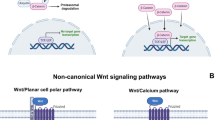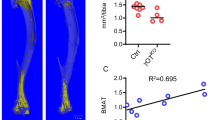Abstract
Purpose of Review
The goal of this chapter is to review the proposed roles for bone lining cells in bone homeostasis. We will focus on how these cells contribute to normal bone remodeling and how they might participate in bone anabolic responses to osteoporosis therapies.
Recent Findings
Lineage tracing methodologies have recently demonstrated that quiescent bone lining cells can directly convert into active matrix-forming osteoblasts in the setting of treatment with parathyroid hormone and anti-sclerostin antibody.
Summary
Bone lining cells are an abundant yet poorly studied cell type in bone. They most likely participate in normal bone remodeling and have important roles in responses to osteoanabolic osteoporosis treatments and in skeletal repair after injury. Novel models are needed to selectively ablate and interrogate the function of specific genes in bone lining cells.
Similar content being viewed by others
References
Papers of particular interest, published recently, have been highlighted as: • Of importance, •• Of major importance
Miller SC, et al. Bone lining cells: structure and function. Scanning Microsc. 1989;3(3):953–60. discussion 960-1
Miller SC, Jee WS. The bone lining cell: a distinct phenotype? Calcif Tissue Int. 1987;41(1):1–5.
Miller SC, et al. Characterization of endosteal bone-lining cells from fatty marrow bone sites in adult beagles. Anat Rec. 1980;198(2):163–73.
Dierkes C, et al. Catabolic properties of microdissected human endosteal bone lining cells. Calcif Tissue Int. 2009;84(2):146–55.
Canas F, Terepka AR, Neuman WF. Potassium and milieu interieur of bone. Am J Phys. 1969;217(1):117–20.
Talmage RV. Morphological and physiological considerations in a new concept of calcium transport in bone. Am J Anat. 1970;129(4):467–76.
Hauge EM, et al. Cancellous bone remodeling occurs in specialized compartments lined by cells expressing osteoblastic markers. J Bone Miner Res. 2001;16(9):1575–82.
Everts V, et al. The bone lining cell: its role in cleaning Howship’s lacunae and initiating bone formation. J Bone Miner Res. 2002;17(1):77–90.
Ducy P, et al. Osf2/Cbfa1: a transcriptional activator of osteoblast differentiation. Cell. 1997;89(5):747–54.
Motyckova G, Fisher DE. Pycnodysostosis: role and regulation of cathepsin K in osteoclast function and human disease. Curr Mol Med. 2002;2(5):407–21.
Nioi P, et al. Transcriptional profiling of laser capture microdissected subpopulations of the osteoblast lineage provides insight into the early response to sclerostin antibody in rats. J Bone Miner Res. 2015;30(8):1457–67.
Ma S, Dai Y. Principal component analysis based methods in bioinformatics studies. Brief Bioinform. 2011;12(6):714–22.
Black DM, Rosen CJ. Clinical practice. Postmenopausal osteoporosis. N Engl J Med. 2016;374(3):254–62.
Reid IR. Short-term and long-term effects of osteoporosis therapies. Nat Rev Endocrinol. 2015;11(7):418–28.
Shane E, et al. Atypical subtrochanteric and diaphyseal femoral fractures: second report of a task force of the American Society for Bone and Mineral Research. J Bone Miner Res. 2014;29(1):1–23.
Neer RM, et al. Effect of parathyroid hormone (1-34) on fractures and bone mineral density in postmenopausal women with osteoporosis. N Engl J Med. 2001;344(19):1434–41.
Jilka RL, et al. Increased bone formation by prevention of osteoblast apoptosis with parathyroid hormone. J Clin Invest. 1999;104(4):439–46.
Nishida S, et al. Increased bone formation by intermittent parathyroid hormone administration is due to the stimulation of proliferation and differentiation of osteoprogenitor cells in bone marrow. Bone. 1994;15(6):717–23.
Wu X, et al. Inhibition of Sca-1-positive skeletal stem cell recruitment by alendronate blunts the anabolic effects of parathyroid hormone on bone remodeling. Cell Stem Cell. 2010;7(5):571–80.
Keller H, Kneissel M. SOST is a target gene for PTH in bone. Bone. 2005;37(2):148–58.
Bellido, T., et al., Chronic elevation of parathyroid hormone in mice reduces expression of sclerostin by osteocytes: a novel mechanism for hormonal control of osteoblastogenesis. Endocrinology, 2005;146(11):4577–83.
Fan, Y., et al., Parathyroid hormone directs bone marrow mesenchymal cell fate. Cell Metab, 2017.
Dobnig H, Turner RT. Evidence that intermittent treatment with parathyroid hormone increases bone formation in adult rats by activation of bone lining cells. Endocrinology. 1995;136(8):3632–8.
Leaffer D, et al. Modulation of osteogenic cell ultrastructure by RS-23581, an analog of human parathyroid hormone (PTH)-related peptide-(1-34), and bovine PTH-(1-34). Endocrinology. 1995;136(8):3624–31.
Madisen L, et al. A robust and high-throughput Cre reporting and characterization system for the whole mouse brain. Nat Neurosci. 2010;13(1):133–40.
Maes C, et al. Osteoblast precursors, but not mature osteoblasts, move into developing and fractured bones along with invading blood vessels. Dev Cell. 2010;19(2):329–44.
•• Kim SW, et al. Intermittent parathyroid hormone administration converts quiescent lining cells to active osteoblasts. J Bone Miner Res. 2012;27(10):2075–84. Here, lineage tracing was first used to demonstrate that lining cells derive from mature osteoblasts. Moreover, genetically labeled lining cells had the capacity to become osteoblasts after intermittent PTH treatment
Miller PD, et al. Effect of abaloparatide vs placebo on new vertebral fractures in postmenopausal women with osteoporosis: a randomized clinical trial. JAMA. 2016;316(7):722–33.
Cosman, F., et al., Romosozumab treatment in postmenopausal women with osteoporosis. N Engl J Med, 2016.
McClung MR, et al. Romosozumab in postmenopausal women with low bone mineral density. N Engl J Med. 2014;370(5):412–20.
Brunkow ME, et al. Bone dysplasia sclerosteosis results from loss of the SOST gene product, a novel cystine knot-containing protein. Am J Hum Genet. 2001;68(3):577–89.
Balemans W, et al. Identification of a 52 kb deletion downstream of the SOST gene in patients with van Buchem disease. J Med Genet. 2002;39(2):91–7.
Estrada K, et al. Genome-wide meta-analysis identifies 56 bone mineral density loci and reveals 14 loci associated with risk of fracture. Nat Genet. 2012;44(5):491–501.
Rivadeneira F, et al. Twenty bone-mineral-density loci identified by large-scale meta-analysis of genome-wide association studies. Nat Genet. 2009;41(11):1199–206.
Baron R, Kneissel M. WNT signaling in bone homeostasis and disease: from human mutations to treatments. Nat Med. 2013;19(2):179–92.
Ke HZ, et al. Sclerostin and Dickkopf-1 as therapeutic targets in bone diseases. Endocr Rev. 2012;33(5):747–83.
• Ominsky MS, et al. Tissue-level mechanisms responsible for the increase in bone formation and bone volume by sclerostin antibody. J Bone Miner Res. 2014;29(6):1424–30. Histomorphometry was used to demonstrate that sclerostin antibody treatment dramatically reduces quiescent bone surfaces. These findings set the stage for subsequent lineage tracing studies to ask whether sclerostin antibody might directly activate bone lining cells
Ominsky MS, et al. Differential temporal effects of sclerostin antibody and parathyroid hormone on cancellous and cortical bone and quantitative differences in effects on the osteoblast lineage in young intact rats. Bone. 2015;81:380–91.
•• Kim, S.W., et al., Sclerostin antibody administration converts bone lining cells into active osteoblasts. J Bone Miner Res, 2016. Lineage tracing was used to track endosteal and periosteal lining cell responses to sclerostin antibody. Like PTH, sclerostin antibody directly converts quiescent bone lining cells to active matrix-forming osteoblasts.
• Matic, I., et al., Quiescent bone lining cells are a major source of osteoblasts during adulthood. Stem Cells, 2016. Lineage tracing was used to demonstrate that lining cells can contribute to osteoblastogenesis in the setting of osteoblast ablation.
•• Zhang, J. and D.C. Link, Targeting of mesenchymal stromal cells by Cre-recombinase transgenes commonly used to target osteoblast lineage cells. J Bone Miner Res, 2016. An important study that clearly illustrates some major technical limitations associated with lineage tracing techniques. Specifically, “osteoblast-specific” Cre driver lines show robust activity in multiple non-osteoblastic cell types.
Taylor S, et al. Time-dependent cellular and transcriptional changes in the osteoblast lineage associated with sclerostin antibody treatment in ovariectomized rats. Bone. 2016;84:148–59.
Ono N, Kronenberg HM. Bone repair and stem cells. Curr Opin Genet Dev. 2016;40:103–7.
Visnjic D, et al. Conditional ablation of the osteoblast lineage in Col2.3deltatk transgenic mice. J Bone Miner Res. 2001;16(12):2222–31.
Ozcivici E, et al. Mechanical signals as anabolic agents in bone. Nat Rev Rheumatol. 2010;6(1):50–9.
Robling AG, et al. Mechanical stimulation of bone in vivo reduces osteocyte expression of Sost/sclerostin. J Biol Chem. 2008;283(9):5866–75.
Tu X, et al. Sost downregulation and local Wnt signaling are required for the osteogenic response to mechanical loading. Bone. 2012;50(1):209–17.
Chow JW, et al. Mechanical loading stimulates bone formation by reactivation of bone lining cells in 13-week-old rats. J Bone Miner Res. 1998;13(11):1760–7.
Mavrogenis AF, et al. Side effects of radiation in musculoskeletal oncology: clinical evaluation of radiation-induced fractures. Int J Immunopathol Pharmacol. 2011;24(1 Suppl 2):29–37.
Dominici M, et al. Restoration and reversible expansion of the osteoblastic hematopoietic stem cell niche after marrow radioablation. Blood. 2009;114(11):2333–43.
Turner RT, et al. Acute exposure to high dose gamma-radiation results in transient activation of bone lining cells. Bone. 2013;57(1):164–73.
Power RA, et al. Basic fibroblast growth factor has rapid bone anabolic effects in ovariectomized rats. Osteoporos Int. 2004;15(9):716–23.
Author information
Authors and Affiliations
Corresponding author
Ethics declarations
Conflict of Interest
Marc N. Wein declares no potential conflict of interest.
Human and Animal Rights and Informed Consent
This article contains no studies with human or animal subjects performed by any of the authors.
Additional information
This article is part of the Topical Collection on the Molecular Biology of Skeletal Development
Rights and permissions
About this article
Cite this article
Wein, M.N. Bone Lining Cells: Normal Physiology and Role in Response to Anabolic Osteoporosis Treatments. Curr Mol Bio Rep 3, 79–84 (2017). https://doi.org/10.1007/s40610-017-0062-x
Published:
Issue Date:
DOI: https://doi.org/10.1007/s40610-017-0062-x




